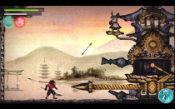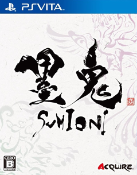Too bad. I'll probably still get it though. I'm a sucker for that Japanese ink art style.
Sumioni: Demon Arts Review
|
|
See PixlBit's Review Policies

On 03/22/2012 at 11:15 PM by Nick DiMola Repetition and missed opportunity make Sumioni extremely disappointing. |

Not recommended, especially at its $20 price.
At face value, it may be easy to mistake Sumioni for a 2D iteration of the Okami series. It has similar sound effects, aesthetics, and settings, as well as the ability to draw on the screen like you do with the celestial brush; even their logos are similar. However, Sumioni doesn’t even come close to matching the merits of Capcom’s sprawling adventure. Instead, Sumioni is a repetitive hack-and-slash that fails to capitalize on its unique design.

After your first few minutes with Sumioni, you’re destined to be enamored. Its wide range of abilities work well and control is extremely smooth. Drawing on the screen to create platforms, light things on fire, summon demons, and even stopping enemy attacks is plain and simple fun. The button-based controls are simple and fluid, making it easy to dispose of foes. However, all of this is wasted thanks to the repetitive nature of the experience.
Sumioni has no aspirations of being anything more than a simple action game. Rather than utilize the drawing mechanics for some true platforming or exploration, they’re merely used as a means of getting to a dominant attack location to best a few token foes, most notably the bosses that conclude most levels.

The flat 2D levels feature little more than simple enemies that pose little threat and a few forts to slow you down. Progress is only impeded periodically by the game, which forces you to defeat a specific enemy or fort before moving on. This makes even the longest of levels take only a few short minutes. Being that you’re awarded a higher ranking for both traversing levels quickly and not taking damage, it’s often in your best interest to rush straight to the end of the level, avoiding enemies in order to take on the boss.
This is a tiresome technique, but one that in some instances is required to simply play more of the game. Sumioni features a number of branching paths, but you don’t have the pleasure of discovering hidden entrances to proceed down them. No, instead you must perfect the level that features the branching path in order to gain access to it. Because the branches go many levels deep, you’ll find yourself not only replaying all of the levels that lead up to the branch, but constantly repeating the level with the branch until you achieve the required 3 star score.

Each subsequent trip down any given branch requires you to once again achieve a perfect score, which produces further repetition. Without a level restart option, you’ll also have to contend with a cumbersome quit and reload process just to give the level another shot.
24 of the game’s 30 levels are tucked away behind these branching paths and unlocking all of them is painful work. It doesn’t help that nearly all levels play out the same, or that the bosses are frequently repeated. With repetitive boss encounters come repetitive techniques for success. Typically, you’ll start any boss fight by summoning at least one of your two demons to deal the bulk of the damage. Depending on the boss you’ll either hang back and attack with fire and lightning, or draw a platform at a vulnerable position, jump on it, and attack until you’re victorious.
Just like the rest of the game, once you’ve established the winning technique it’s just a matter of going through the motions in each and every level. It’s Sumioni’s greatest downfall: insane amounts of repetition. It’s structurally sound and full of unique designs and mechanics, but none of it is used in an interesting or memorable way. After two hours, it won’t matter if you haven’t seen half of the game, you won’t want to play any more of it anyway.










Comments